Victorian Women Dresses 1800 Images About Late Victorian Fashion 1890-1900
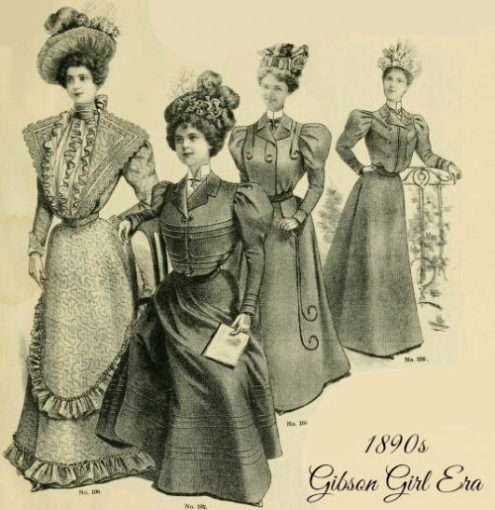
1898 fashion
The 1890s through 1905 is office of the belatedly Victorian fashion era, otherwise known every bit the Gibson Girl era. This was the fourth dimension for the 2-piece skirt and blouse set to sally with style. Dana Gibson created the iconic Gibson Girl look with actress-broad puffy sleeve blouses paired with a curved corseted waist, a-line skirts, voluminous Gibson pilus topped with large blossom and feathered hats. This expect lasted 25 years just gradually slimmed down to a more than manageable fashion. Thanks to special wearable for cycle riding, hiking and horseback riding, women'southward clothes were a scrap shorter, freer and more comfortable than the preceding Victorian years.
Read on to learn nigh the late Victorian era 1890s mode history, links to ready-fabricated habiliment/costumes and links to patterns to sew your own.
1890-1900 Way
Victorian Costume and Costume Accessories by Anne Buck, published 1961, copyright expired
The change of style that set the dress of the 1890s apart from that of the 1880s was a alter of accent from the skirt to the bodice. The brim that, with its complication of drape, had been the master feature of wearing apparel between 1875 and 1889, now became "scanty and unimportant" in the words of a journal of 1890.
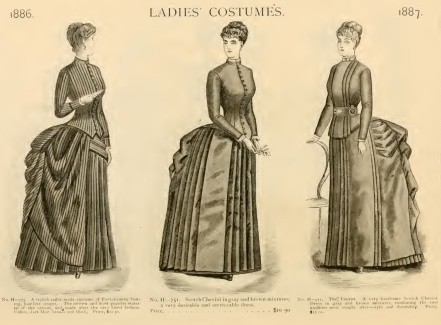
1886 -1887 hurry dresses
From 1886, skirts became less and less trimmed, their drapery fell in plainer lines, only, except in the severer tailor-made clothes for country and active clothing, the double grade of skirt with a draped tunic or overskirt remained until 1889. In the 1890s, this form disappeared from day dresses during the start years of the new decade, and from more formal and elaborate dresses a year or two later.
The skirt now fitted closely at the waist; fullness all fell from the center back, unsupported by any bustle or steels, plain and untrimmed, in a flowing line to the ground. It was this new line of the skirt which was the important change of the 1890s, although information technology was the bodice which now received fashionable attention.
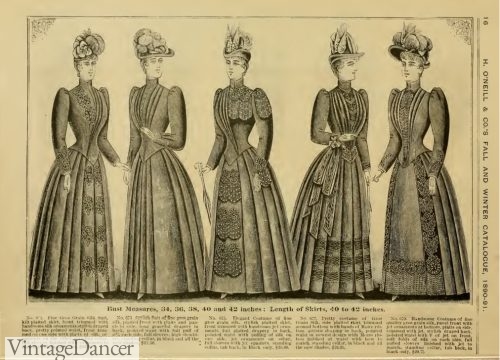
1890 Wearing apparel bodices and skirts
The bodice generally remained a rigid, corset-like grade. There was no relaxation of its boning and the waist measurements of the bodices of the 1890s are as small as in any period of the century. In mean solar day dresses, the standing collar of the 1880s, which had grown higher by 1890, became college nevertheless, two inches or more, by the late 1890s, and remained loftier into the new century.
From 1890 to 1892, the sleeves were narrow with the small puff ascent higher up the level of the shoulder, which had already appeared in 1889. From 1892, the upper half of the sleeve began to swell and grew wider and wider until 1896.
1890s Evening Gowns
In evening dress, a short but extremely total and puffed sleeve, catastrophe at the elbow or just earlier one, spread out sideways instead of ascension above the shoulder. "All fullness has vanished relieve at the shoulder where pointed and square epaulettes, puffs or butterfly arrangements maintain their wide outcome which makes the waist look pocket-sized."
The waistline in 1890 was low and there was an accent on vertical lines throughout the clothes. The revers of the jacket bodices, which were much worn, were frequently long and narrow, and the bodice trimming formed a shut, deep Five-shape on the front. By 1893, the revers of this type of bodice were condign larger and, as the sleeves spread out widely, the revers spread towards the shoulder.
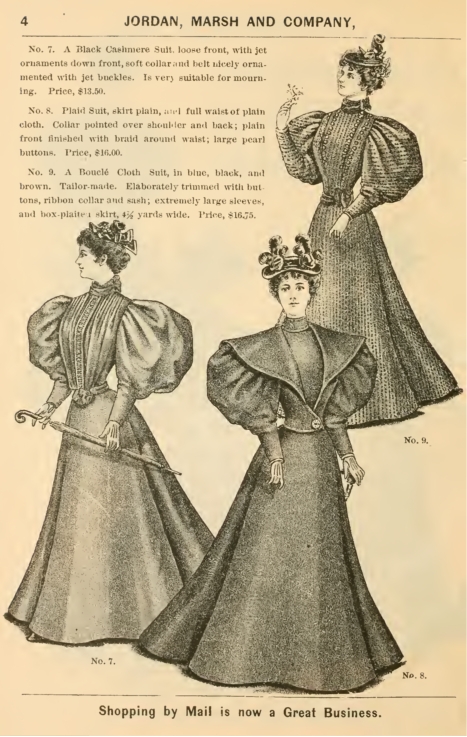
1895 Ladies suits, narrow waist
On evening dress, revers spread as epaulettes over curt total sleeves; or a deep berth of lace spread over them. In 1893, in that location was a full sleeve which sometimes fell off the top of the arm, and so that it continued the line of the bodice across the arm; the bodice was held over the shoulder past narrow shoulder straps. All possible width and decoration were given to the upper one-half of the bodice to emphasize a small waist beneath.
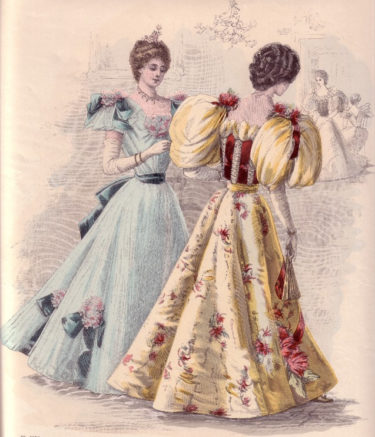
1892-iii evening ballgowns
A yoked bodice had already appeared in 1890, and yoke shapes, square, round or V-shaped appeared on many dresses of the 1890s. The yoke was usually a trimming only, not a construction, and it was often frilled. The tight fitting bodice was usual, but many bodices were fabricated with a loose section at the center front over a closely fitted lining, especially towards the cease of the decade.
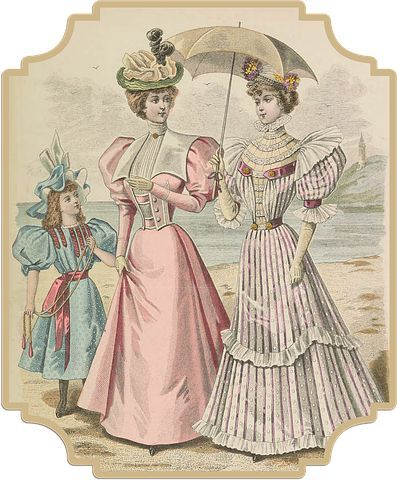
1890s Summer Dresses
1890s Suits and Blouses
Nearly all the fullness and looseness which appeared in the bodices of the 1890s was deceptive. The full sleeves of day dresses were made on a lining which fitted the arm. The loose bolero and open jacket forms were often not what they seemed, only an applied trimming of a bodice on a shut-plumbing equipment boned lining.
Past 1897, a bolero, or bolero effect, "appears on well-nigh every clothes, either for morning or evening wear, and in every variety of fabric from velvet to lace, and this connected to the stop of the century.
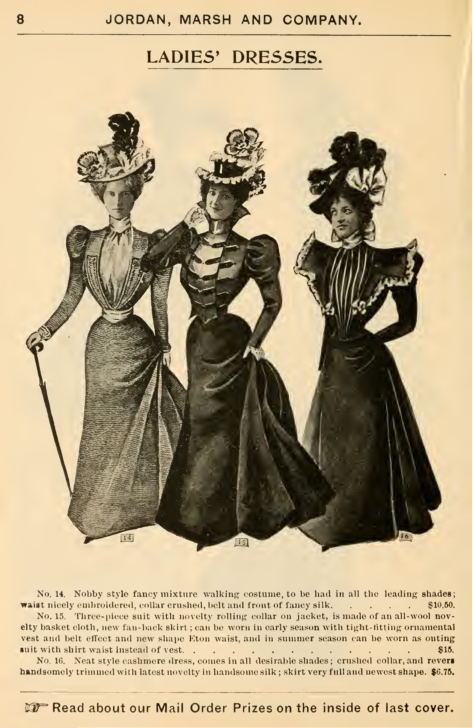
1897 Walking dresses and suits
In that location was one form of bodice in detail which adult and flourished in the 1890s. This was the blouse. A loose informal bodice, worn with a contrasting brim, with or without coat or cape, had appeared as far back as the 1860s. A loose belted tunic had been worn in the 1880s, but by 1890 a blouse was more than the occasional garment of informal wear. Information technology appeared on about evening dresses between 1892 and 1897.
"Blouses accept grown and so much in popular favour during the last few years that from neglige garments of the loosest, baggiest and near unpretentious clarification they have adult into the favorite bodices of the historic period, making an appearance on the most important occasions … so much caught down and pleated and pressed into shape upon a close fitting lining that their leading characteristics take well-nigh disappeared" (Woman's Globe, 1890).
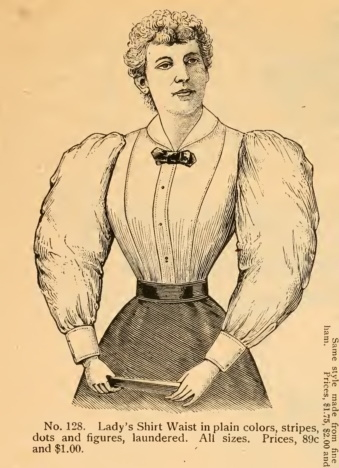
1894 shirtwaist (blouse)
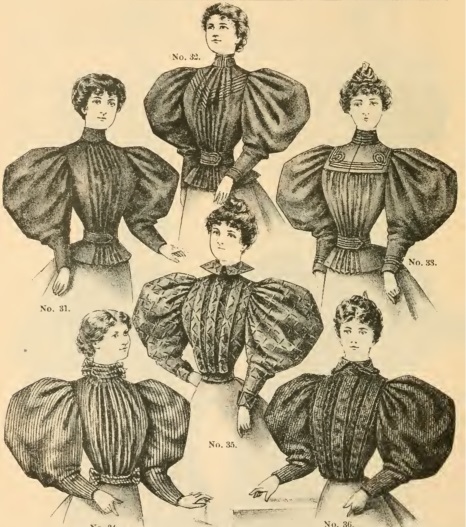
1895 Ladies blouses with mutton sleeves
In 1897, the fullness left the sleeves in the aforementioned fashion as it began, with a small puff still remaining at the shoulder; but this puff, in function, lost its original divergence from the bodice, and many blouses of the 1890s were as rigidly boned every bit whatsoever of the dress bodices.
The blouse was worn with a contrasting skirt. It could exist worn with any skirt, and a single skirt could accept its appearance renewed past the wearing of unlike blouses. The blouses varied from the plainest shirt-like garments to elaborate constructions and trimmings of silk and lace. The fashion persisted throughout the 1890s.
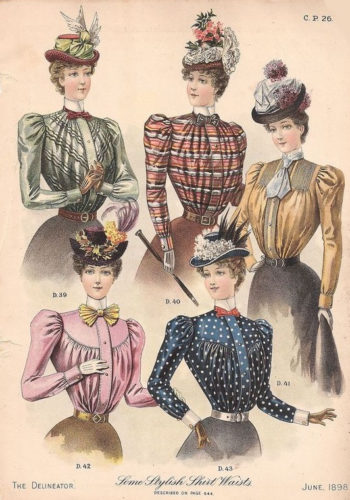
1898 blouses with minor puff sleeves
The popularity of the blouse meant a change in the component parts of the tailor-made costume. The early tailor-made costumes of the 1890s were either dresses, the bodice worn with a waistcoat or having a waistcoat front, or they were dresses with matching jackets.
"Tailor-made dresses of tweed, cloth, etc., are equally a rule very unproblematic in style to be suitable for traveling and walking, simply like near all other gowns they take waistcoats which are ofttimes of bright colours" (Sylvia'south Home Journal, 1885). It was not until the 1890s that the form of coat, skirt, and blouse was established, a form which has never since been absent from the dress of Englishwomen. The wearing of this form of dress increased during the 1890s:
"This we have at to the lowest degree the grace to encourage from year to yr . . . the coat and brim worn with shirt and blouse. This appears this season in larger variety than ever" (Queen, 1893).
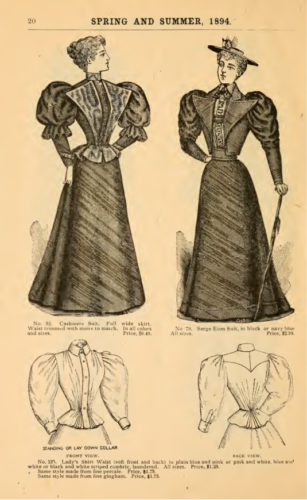
1894 blouse, jacket and skirt outfits
The bodices of evening dresses commonly fastened at the back just sometimes in the forepart. Those of the day dresses usually fastened in front, the fastening oftentimes being on the bodice lining with the bodice forepart overlapping. Some have a cross-over draping. They were usually boned, with five bones at the back, a bone at each side seam and two each side of the front opening. But, different the bodices of the 1880s, they were, by the mid- 1890s, very often without a middle back seam.
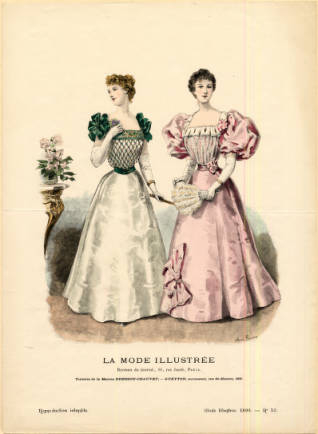
1895 evening gowns
The high neckband oftentimes had a stiff interlining, just in the last years of the century, information technology oft appeared as folded bands of cloth. The belt or waistband might also show this folded form. Belts, with the wearing of blouses and skirts, the short bolero jackets, and the emphasis on a small, neat waist, became a more important accompaniment in the 1890s than they had been since the 1870s. Buckles were used ornamentally and there was a revival of the buckle forms of the eighteenth century and the utilize of surviving eighteenth-century buckles.
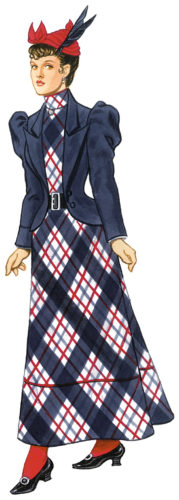
A belted traveling conform, 1891
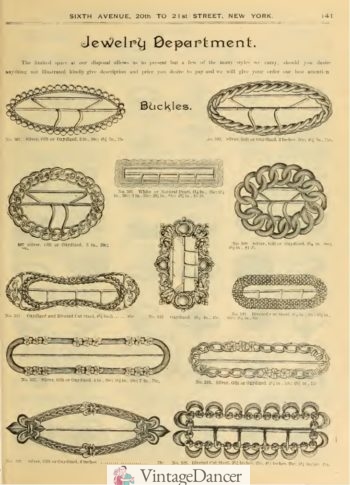
1890 buckles
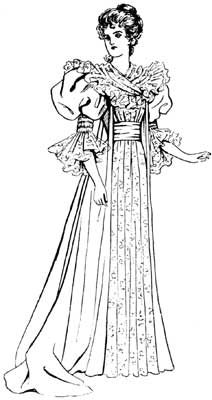
1897 Empire waist tea gown
The tea-gown continued in use for the whole of the 1890s. As in the 1880s, information technology differed piddling from the most elaborate dresses, except in the looser lines of the bodice and a tendency to go along the front-fastening princess course. Many of the tea-gowns of the 1890s were in the "Empire" style, falling loosely from a high waistline, inspired by the fashions of the early on nineteenth century. This style was sometimes used for evening dress. Read more near Victorian Tea dresses.
1890s Skirts
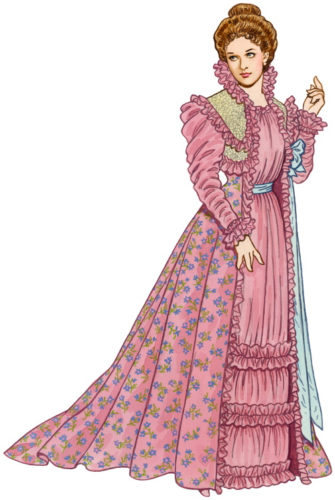
1898 pink tea gown
As the sleeves spread and gave width to the bodice from 1892, the skirt widened at the hem. The fullness was still swept to the center back, but, by 1893, five and a half yards was often given as the usual width for the brim at the hem. For daywear, the skirt still cleared the ground, until 1898. "Happily they continue brusque—a blessing for which we accept to give thanks the wheel."
But from 1898 they became longer and had to be held up in walking. Trained gowns for wagon wear were already fashionable in 1897. The manifestly line of the skirt at present began to disappear in trimming. In the lighter materials, particularly, skirts trimmed with tucks circular the skirt from waist to hem, or with apron trimming continuing as a flounce at the hem, were general past 1897. "The trimmed brim now holds the field entirely in all dresses of this light clarification" (Lady'due south Realm, 1898).
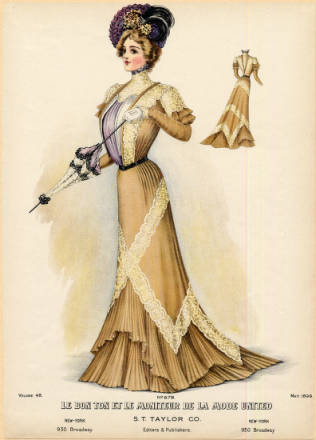
1899 flounced long skirt, tucks at the waist
The shaping of the skirt of the 1890s was accomplished by gored cutting and by plumbing equipment over the hips with short darts. The number of gores in the skirt varied; double-width textile was used, cut on the cantankerous in fewer sections, but the narrower materials were cutting in four or five gores at each side of the front width.
Simply, the skirt of the 1890s was given its characteristic shape, until the last two or three years of the century, mainly by the cutting of the back breadths on the cross and joining them with a seam at center back on the cross cut. This menstruation at the back of the skirt was modified past the add-on of secondary gores or wings in the seams in the lower part of the brim, then that the fullness spread round the hem. This appeared as early on as 1893; but, it did non modify the skirt line noticeably until 1897, when the fullness was lessened in the upper part of the skirt, which fitted closely over the hips, leaving the still full lower half in a flounced line at the hem.
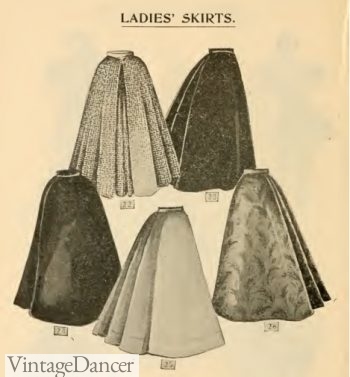
1897 Victorian Skirts
A new blazon of skirt which had a total circular flounce below the knee joint likewise gave the same change of line from 1897. Skirts pleated from the waist were also worn at this time, particularly for dancing. "New fan-pleated or 'sun-ray' skirts, 9 yards at hem, one yard at tiptop" were noted past the fashions of February 1897.
Once more the skirts were lined, often with a silk lining, and as they became fuller they were often made with stiffened interlining every bit well. Dresses at present had to please the ear as well as the eye. "One of the ambitions of dress just at present is the rustle. The frou-frou of a gown is one of its desired merits" (Queen, 1893). The silk of the lining inverse from the rustling glace or taffeta to softer silk in 1898. "All our dresses will be mounted on the softest of linings, for to rustle we have now no desire" (Lady'due south Realm, 1898-nine).
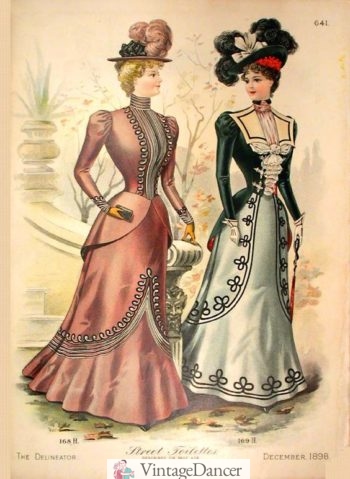
1898 flared skirts
A new style was first to evolve in the final three years of the century. The change in line was slight but significant. The changing construction of the skirt caused it to fall in more than curving lines at the hem and to fit more slimly over the hips. The bodice had lost its fullness of sleeve. In its plainer forms, the apparel of these years may appear every bit a simple style; but in fashionable clothing, the apparent simplicity was and so overlaid with trimmings and veiled by its materials that the dress took a new character from them in reaction from the astringent tailored style of the early 1890s.
1890s Fashion Fabrics & Colors
There was besides a change in the apply of materials. Until the late 1890s, the heavier cloths —satins, richly-figured silks and stiff slippery silks —were worn, stiffly lined. In the last years of the century, it was the soft, clinging materials that were chiefly used. "All clinging materials will be used and fifty-fifty textile will exist of a soft texture" (Lady's Realm, 1898-9).
Velvet was fashionable and the soft, lustrous silk crepe, crepe-de-chine. The low-cal open materials in silk, cotton and wool were even more characteristic. In woolen fabrics, "De laine, the old mousseline —that is a thin texture of muslin, made with wool—is again seen, printed or patently" (Ladies' Treasury, 1894), and was a favorite cloth, as is seen in many surviving dresses.
Muslin itself, also plain or printed, was much used. Silk gauzes and muslins were fashionable, particularly chiffon, a fine silk muslin. This textile was existence used for evening wearing apparel in 1890, and it became more and more stylish, particularly for trimmings. "Everything is veiled or trimmed with chiffon, jeweled net, the flimsiest of gauzes" (Lady's Realm, 1898). It was used for the flimsy scarfs which were folded twice round the neck and tied in a bow or knot in front, and for frills everywhere. With these low-cal materials, a good bargain of lace was also used.
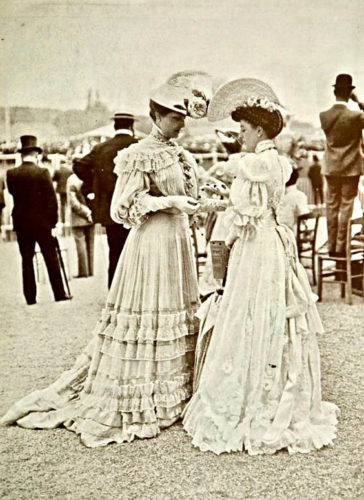
1898 ruffles and lace gowns
In the early on 1890s, it appeared chiefly in deep berthes or epaulettes, or in deep flounces falling from curt puffed sleeves, but in the late 1890s it was much used as office of the fabric of the dress. All types of lace were used, and old lace was brought out again for another wearing on dresses and blouses of these years. "We are to apply a good bargain of lace, old lace and new, but the new is made to simulate the erstwhile equally much as possible" (Queen, 1893).
Lace blouses were particularly popular: "It is essential to the conduct of all proficient wardrobes that they possess a lace bodice, if not two, the one high, the other low" (Gentlewoman, 1897).
Tucks, very fine tucks round the skirt and bodice, were a specially characteristic trimming of these years. On the tailor-made cloth dresses and coats and skirts, braiding of all kinds and applique of velvet were the usual trimming, and embroidery also ornamented all materials from cloth to internet.
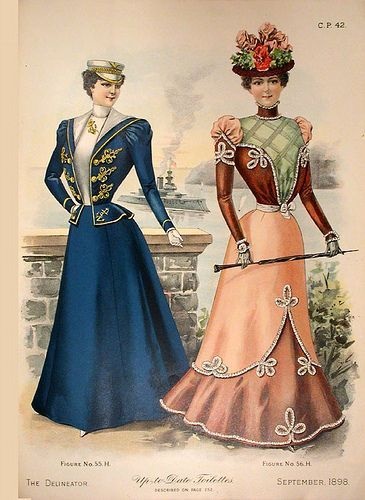
1898 Dresses with braiding and applique trim
Blueprint shared the general softening of outline. The warp printed chine silks were stylish. Floral patterns in abaft lines, and floral forms loose in outline, appeared in the printed fabrics. "The plainest dresses will have floral designs trailing over them" (Lady's Realm, 1898). Rarely were pattern and basis of woven fabrics sharply defined; and all might be veiled by lace, cyberspace or chiffon.
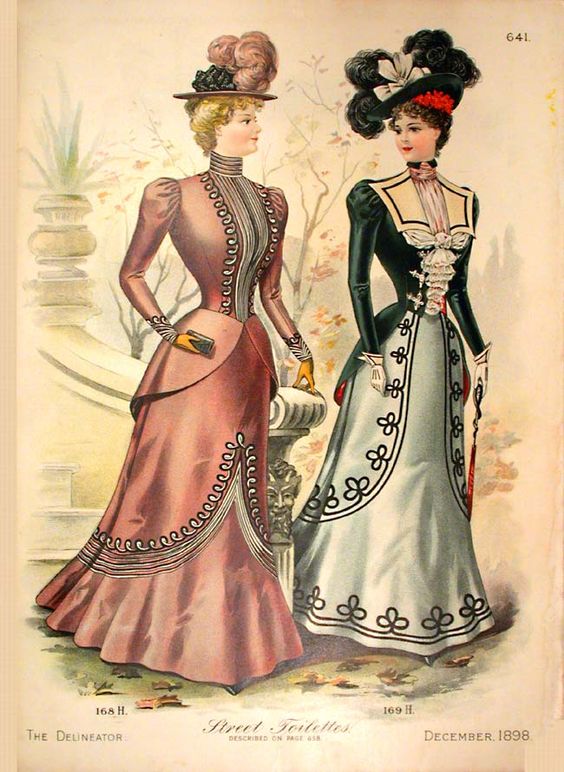
1898 colorful suits
Color, too, became paler, except for the strong contrast of black and white, which was fashionable for most of the 1890s. At the outset of the 1890s, yellow had been a fashionable colour, and all shades of purple. The vivid contrasts of the 1880s continued in the early on 1890s, but gradually faded into paler tones.
The mingling of mauve and low-cal green, 'heliotrope and chartreuse', was particularly characteristic for about of the decade. The change which marks the stop of the Victorian period in women's clothes came in the yr of the Diamond Jubilee, not with the end of the century or the expiry of the Queen. The fashions of the terminal years of the century were the beginnings of a new form which did not accomplish its climax until the next reign and the next century.
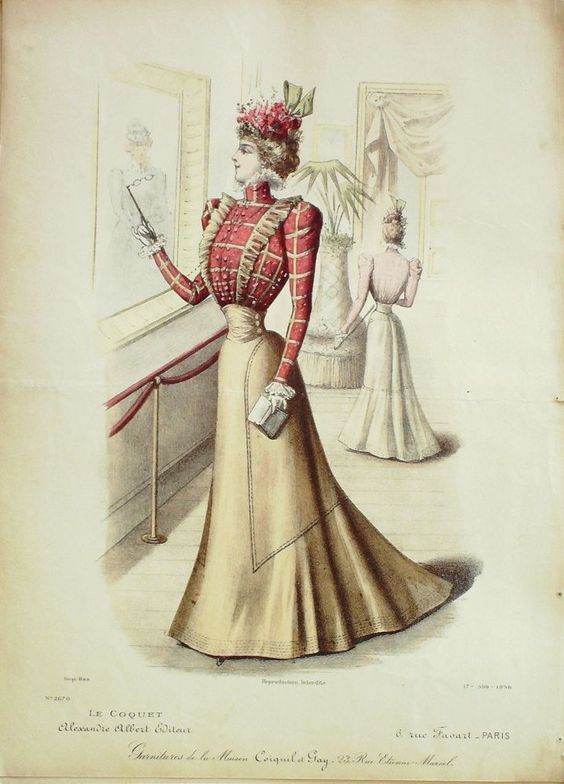
1898 Blouse and Skirt
More 1890s Mode History
Here are some links to more than Victorian fashion history articles:
- History of 1890s 24-hour interval Dresses.
- 1880-1914 La Bella Epoque History.
- Republic Vintage Dancers: 1890s Costume Hints.
- UVM- Women'southward Clothing of the 1890s.
- tudorlinks.com – A very detailed review of 1890s clothing and 1900-1919 Wear.
- Tea dresses – All well-nigh the popular white apparel worn for tea and garden parties in the Victorian and Edwardian eras.
- My 1890s wedding gown – All about my Victorian themed wedding in an inspired 1893 Worth dinner gown.
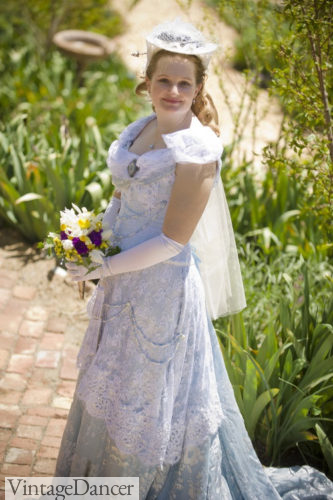
My final gown- isn't information technology cute! Fifty-fifty more then in person
1890s Outfit Guide
"While most of united states do not accept 1890s style ballgowns hanging in our closets, 1 might well take or be able to find an old party dress which has like lines. A manifestly neckline tin be enlivened with a curtain of lace pinned in place with a few sparkling brooches. A less than floor length brim tin be extended past adding a broad ring of fabric to the hem, or by wearing the dress over a flooring length skirt and perhaps pinning the shorter dress skirt into attractive puffs, scallops or swags. Unless the skirt is too narrow to allow it, a net petticoat or crinoline volition contribute to the bong-like silhouette and requite the skirt more than flare." – Commonwealth Vintage Dancers
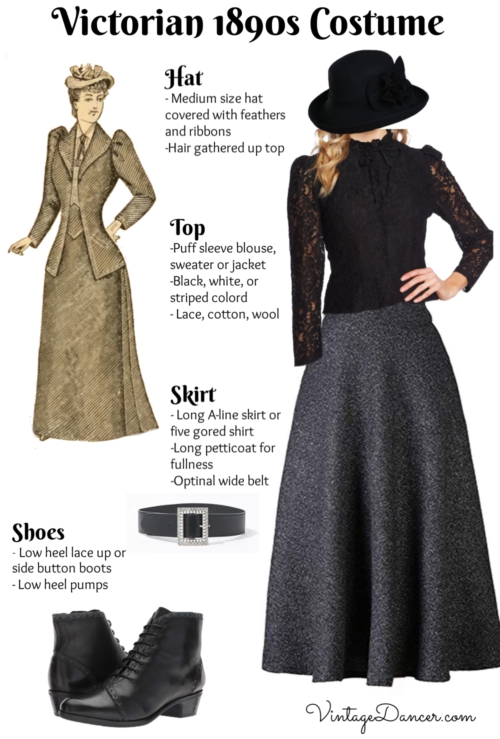
Easy 1890s outfit
Read my quick guide to turning a skirt and blouse into a late Victorian costume.
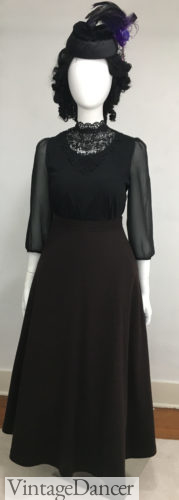
Simple outfit- Skirt and blouse with hat. That'southward all you demand.
The Pragmatic Costumer has several thrifty ideas on creating a Gibson Brim and Blouse Set up.
Shop 1890s Wearable, shoes and accessories
Victorian dresses – A mix of 1840 to 1890s manner Victorian dresses for sale.
Victorian blouses – New blouses that can piece of work for this era.
Victorian skirts – New total length skirts in the cut and patterns of the Victorian to the Edwardian era.
1890s shoes came in lace up or side buttoning "granny boots," some with contrasting white or tan spat tops. For evenings, basic pumps made of silk were apparently but pretty. Twenty-four hours time shoes featured the low heel walking Oxford.
Shop Victorian boots and shoes.
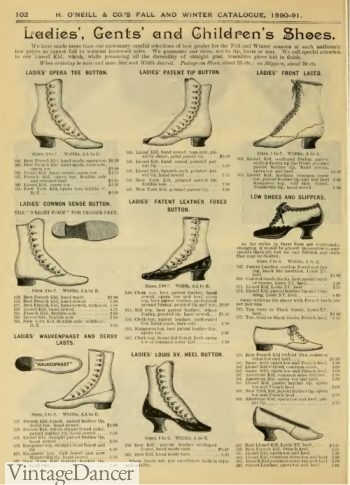
1890 white "spat" boots, oxfords and pumps
Victorian hats – Larn the history of Victorian-era hats. Shop hats hither.
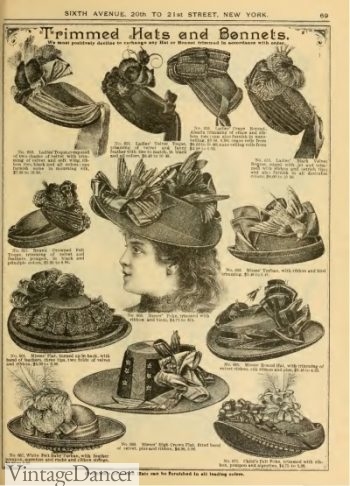
1890 Victorian Hats
0 Response to "Victorian Women Dresses 1800 Images About Late Victorian Fashion 1890-1900"
Post a Comment